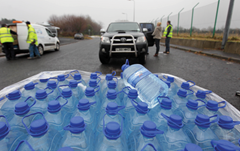Crisis communications: Paul McGarrity
I nternet consultant Paul McGarrity tracks the key shifts taking place in the modern media and suggests how to put out clear messages online when crises occur.
nternet consultant Paul McGarrity tracks the key shifts taking place in the modern media and suggests how to put out clear messages online when crises occur.
The recent uprisings in Middle Eastern states and various corporate crises reveal the often huge gap between an old guard using traditional media and the tech- savvy general public.
This was certainly the case during the Egypt crisis. In one corner stood an authoritarian government trying in vain to push 1970s-style TV addresses claiming: “Revolution? What revolution?” In the other corner, an angry populace organised street protests via twitter with local souk owners able to upload video footage of the unfolding chaos in Cairo to be screened by BBC and CNN, and watch it spread virally through the internet.
The past decade has witnessed an astonishing change in how we use and consume media. However, the changing patterns and trend of consumer media hasn’t been reflected in how some corporations, businesses and
organisations communicate with their stakeholders, not least during some high profile crisis incidents.
The perfect storm
Huge advances in digital media are also occurring alongside fundamental shifts in modern society, including the following:
• People power – The characteristics of new media (transparent, community- orientated, openness, instant) help create a new power shift away from traditional élites, such as news broadcasters and CEOs, and give more power to consumers.
• Information culture – Over the past few years we have entered what I call the ‘age of information entitlement’. We know that with so much digital media content on the internet, there’s now a culture of expecting the right information and getting it right now.
• Reputational scrutiny and the recession – Another important factor in the modern media environment is the level of distrust in corporations and the media. We are now much less likely to trust authority, especially corporations and the messages they push.
Up until recently, PR managers could rely on the traditional media to disseminate messages and updates during a crisis incident. Of course, traditional PR still plays a hugely important part in a modern crisis response. However in the digital age marketing, PR and communications departments need to learn how to integrate online and social media effectively. So what are the main online media and tools you need to be aware of and what role do they play in managing crisis communications?
Website
Your website is perhaps the most fundamental part of your brand presence online. However it’s important to check that your website is functional. One of the major problems during the Northern Ireland Water crisis was the inefficiency of its website. Rather than invest in a customer-focused website, the company was stuck with an outdated corporate website that was unable to communicate real-time updates. It certainly compared less favourably to many rival water companies in Britain who had invested in websites which integrated their facebook and twitter profiles, the company blog and even online video.
Social media
Social media channels such as facebook have become very popular among the general public. As such, more marketing effort is now being devoted to developing engagement strategies and activity. Many companies have invested heavily in their social media presence. One example is US airline Jet Blue which has used its facebook page to communicate quickly and successfully during a crisis by posting updates and responses to consumers.
Through your twitter profile you can create real-time messages of 140 characters and update people who are following your profile. twitter is definitely one of the top online tools for communicating real-time messages during a crisis.
Online video
With an iPhone or digital camera, anyone can record, edit, upload and distribute a video attacking your brand within minutes. In extreme cases these videos can go viral and appear high on search engine results. However, there are also opportunities for brands to use video during crisis periods. If you are sincere about maintaining public confidence during a crisis, then a crisis response video from your spokesperson hosted on your website will be an important step.
Blogs
You can also communicate information and messages quickly during a crisis by using a blog. If you have one of your spokespersons blogging during a crisis, it will also make the organisation sound less corporate and more human.
Online monitoring
Probably the most important tool to use during a crisis in the digital age is an online monitoring system. It’s amazing how many businesses and organisations don’t monitor what’s being said about
them online. During a crisis it’s vital that you learn how the crisis is unfolding online. Remember, monitoring tools such as Google Alerts are free.
Paul McGarrity is the Managing Director of Octave Online Communications, based in Belfast.
The Kryptonite Crisis
Background: One of the most famous online brand attacks was the Kryptonite story. Kryptonite is one of the largest bike-lock companies in the world and takes huge pride in the legendary security of its products.
What happened: Back in 2004, the company was the victim of a full-scale online brand attack. Kryptonite discovered a short YouTube video called ‘How to pick a Kryptonite bike lock with a Bic pen in 10 seconds’. The video spread like a contagion through the internet and was seen by hundreds of thousands of people. This caused real reputational damage to the Kryptonite brand.
1. Update your crisis PR plan – review your current use of online media channels and how you could use them in a crisis.
2. If you are confident with online and social media use in the good times, you are better prepared for the bad times.
3. Monitor your brand terms online – learn from online chatter during a crisis.
4. Register and safeguard your online channels – register your own facebook and twitter profiles before someone else does. If you don’t, you can’t use them to communicate in a crisis and, what’s worse, someone else can even steal your profile and impersonate you.
5. More than words – consider using video broadcasts to help foster goodwill, educate and appear less corporate.
6. Don’t just leave it to the intern – make sure directors and marketing managers are comfortable with online and social media and that responses are from the top down.
7. Get trained in online media and marketing before a crisis unfolds.






